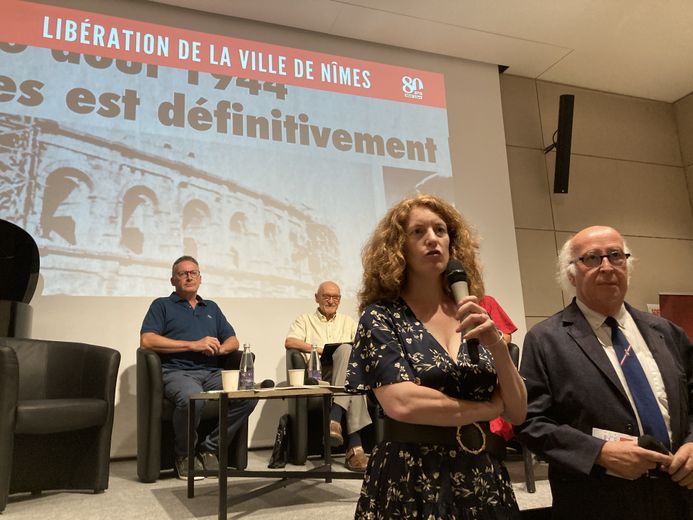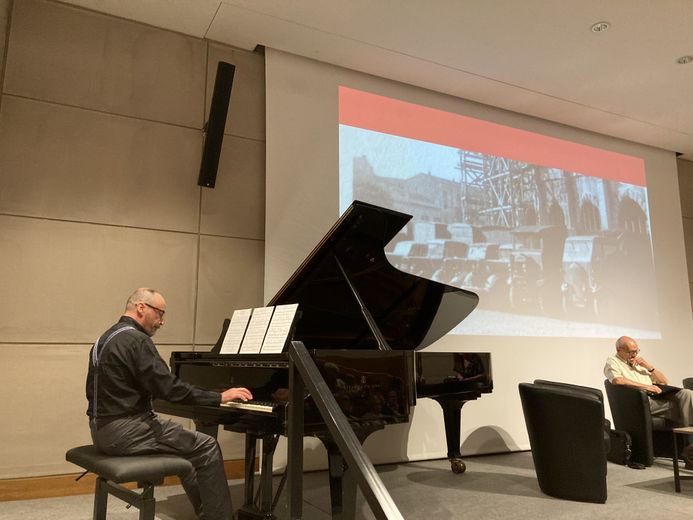VIDEO. Liberation of Nîmes: a conference to make the word resistance resonate again
Organized at the Carré d'art by Midi Libre and the City of Nîmes, to mark the 80th anniversary of the liberation of the city on August 25, 1944, a conference brought together historians and witnesses of the time, in front of a passionate audience.
“Nîmes is a city of freedom and resistance”. It was Daniel-Jean Valade, deputy mayor, who spoke this Wednesday, August 28, in the Carré d'art auditorium (in the absence of the mayor who is convalescing) to launch the conference organized on the 80th anniversary of the liberation of Nîmes. “How does this word resistance still resonate today ? By saying no to demagogy, stupidity, meanness, by remaining vigilant in the face of communitarianism… and Parisian diktats !", he launched.
The tone was set to open the two round tables hosted by Emilie Bec, agency head of the Midi Libre editorial office in Nîmes. On the occupation first, before the liberation of Nîmes on August 25, 1944.
The Germans entered Nîmes on November 11, 1942
Until November 1942, we must imagine a city that experienced the war from afar and only suffered it “through the flow of refugees who arrived, many of them from Alsace-Lorraine. The population drops from 900,000 to 200,000 inhabitants,recalls Armand Cosson, former history teacher at the Daudet high school, former president of the Nîmes History Society and specialist in the Second World War. The Germans arrived in Nîmes on the afternoon of November 11, 1942, and took over the prefecture and key locations.

Emilie Bec, head of the Midi Libre agency in Nîmes, and Daniel-Jean Valade, deputy mayor, opened the conference on the 80th anniversary of the liberation of Nîmes.
“It takes the locals a while to realize it. Before that date, there were no Germans here. Life was ordinary despite the very authoritarian Vichy regime.” The German occupation marked the beginning of the resistance movements, which would gradually take shape – Combat, National Front and Francs Tirers et Partisans (FTP) – and the first attacks from 1943.
“We have a duty of History”
How to transmit to younger generations what life at war was like, life under German occupation 80 years ago? To make his students understand that the actors in the war, those who joined the resistance, were the same age as them, Didier Lavrut, a former history teacher at the Daudet high school, organized meetings with actors in the war. “Very strong moments”. “But alas there is no lesson from history. If it were enough to explain so that “this would not happen again, “this would be known.” He pleads for “a duty of History before a duty of memory” to “establish the facts, explain them “but without illusions alas".
Francine Cabane, also a history teacher, confronted her students with resistance fighters who came to give their testimony “in very rich exchanges with people who risked their lives” . Students told her: “I was no longer the same after.” The power of history embodied by those who made it. Francine Cabane insists: “We must repeat to young people that fighting for freedom is not an old story. Otherwise, we are condemned to always relive the same things.” And make them understand that it is not all black or all white, the complexity of this period”.
The population is hungry
Very quickly, with the German occupation, supply problems will starve the population. There is a shortage of everything, “especially meat and dairy products”, says Armand Cosson who wrote a book on “Nîmes and the Gard, daily life under the occupation”.
The daughter of a resistance fighter, Arlette Chavanieu, well known to the people of Nîmes for having long run a counter at the market halls, remembers the family stories that rocked her youth. “My grandmother got up every day wondering what she would make her children to eat. “I'll never be able to make my mother eat Jerusalem artichokes again,” she smiles.
She also mentions her aunts, “the youngest who really suffered from malnutrition, with consequences for her health, the other who braided shoes at home to exchange them in Lozère for food. And you didn't want to get caught on the way back with a suitcase full of sausages!” The ratting tickets will last until 1949.

Musical interlude between the two round tables with the “Chant des Partisans” and “Qu'est-ce qu'on attend pour être heureux ?” Midi Libre – K. H.
Rascalon, the first maquis in 1943
Armand Cosson explains that during the occupation most people were mainly concerned with daily survival. “Progressively, there was awareness and commitment. The first maquis was born in Nîmes at the beginning of 1943. Rascalon is even the only urban maquis. But he did not hold out for long and had to retreat to the Cévennes”.
Alongside the resistance networks, “a militia was born in January 1943, mainly young men, it would number 700 people in the Gard". And a collaboration group “with lawyers, intellectuals who rallied to the idea of a German Europe".
The armed resistance was the networks and the maquis. Arlette Chavanieu remembers her grandfather's stories, “I think he lived it with joy despite the risks. They were young, they didn't think they were heroes, there was a certain recklessness. ”
But the resistance was also these small acts of everyday life, of disobedience or daily ill will, that everyone did at their own level to stand up to the occupier.




